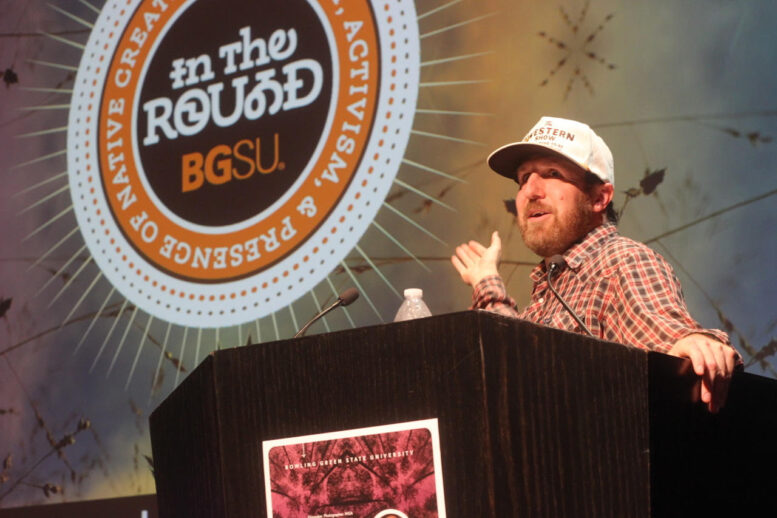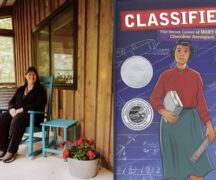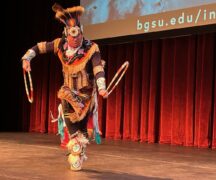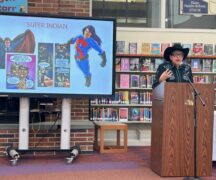By DAVID DUPONT
BG Independent News
Ryan RedCorn checks off a lot of the boxes as an indigenous creative.
The first fall In the Round Series speaker at BGSU is a filmmaker, scriptwriter, songwriter, and graphic designer.
But he told an audience of students, faculty, staff, and community members that my identity is not wrapped up in writing, film making, photography, graphic design, nothing like that.”
A member of the Osage Nation, RedCorn finds his identity as a human and as an artist in the Oklahoma community he grew up in and has settled into. His creative work grows from those roots.
He didn’t move to the film centers of New York or Los Angeles. If he took his talents there, no one would care, he said. And when he left, no one would care. Instead, “I’m a living breathing, everyday member of my community. My kids go to Osage immersion school, my father was assistant principal chief.
“These are the people who are going to bury me when I die,” he said. “So, if I succeed or if I fail at something or make an ass of myself, even here, I don’t care because I’m good with that community.”
RedCorn started his presentation by showing his short film “Dead Bird Hearts.”
Then he cut right to the question-and-answer portion of the presentation. He didn’t want to send 35 minutes talking about something the audience, particularly the students, had no interest in, he explained.
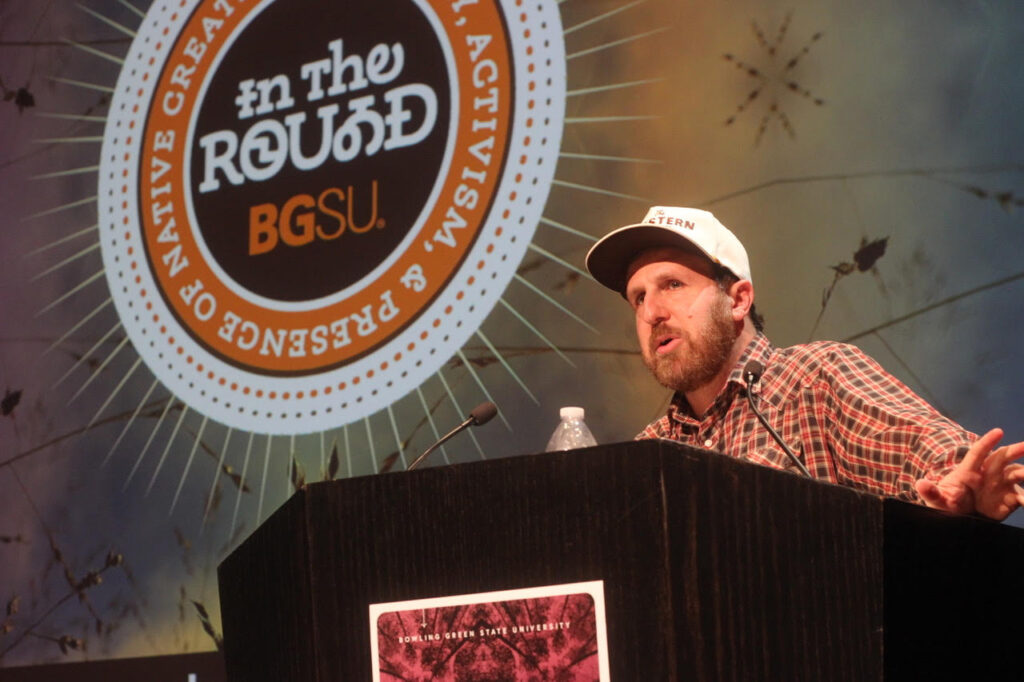
The first question was about the cameras he used to make “Dead Bird Hearts.”
The film is about a lonely, loser, Bernard. Not a likable guy, but RedCorn succeeds in having the viewer develop empathy for him.
It’s a sly comedy, blossoming from the same milieu as the Hulu comedy “Reservation Dogs.” RedCorn is a writer for the show, though he said he never really considered himself much of a writer until the 1491s, a comedy ensemble he helped found, was commissioned to write a play for the Oregon Shakespeare Company.
RedCorn draws on the people and resources he knows.
The actor who plays Bernard is a singer, but never acted before or since, not even in a middle school play. But he’s a member of the community.
“When you live in a small town, you’re left with the weirdos you’re surrounded with, and you write characters who are weird in the same way they are and then you cast them as themselves.”
“Dead Bird Hearts” was produced under the financial restraints independent film. “The people who hold the money love to fund stories about Indians being drunk and poor and dying,” he said. “Trauma porn.”
Instead, RedCorn mocks, that. He said the 1491s video that provoked “the craziest, most racist response” was a series of Indian boarding school survivors smiling and laughing.
He funded “Dead Bird Hearts” with a small screenwriting award and his income from “Reservation Dogs.”
That meant cutting some corners. Someone pointed out that because there’s a campfire in the movie, he needed a “fire wrangler.” He took on the role himself.
And the dog Phyllis serves as Bernard’s only companion. But a real dog would cost $1,500 a day plus a hotel room.
Instead, the dog is played by Sokaogon Chippewa actress Jennifer Rader in a dog costume. (Afterward, RedCorn said he’s not familiar with A.R Gurney’s play “Sylvia,” which revolves around a dog played by an actress.)
Rader was one of the experienced actors on the shoot. “The version I got from Jen is totally different. Because of her ability and skill, I was able to lean into the relationship between Phyllis and Bernard.”
Also, in the cast was Everett Waller, a member of the community who also is in Martin Scorsese’s “Killers of the Flower Moon.”
RedCorn said he knew Waller wouldn’t bother to memorize lines, so he set up the situation. Waller’s uncle character shows up at the campfire next to Bernard.
“Give him a good talking to,” RedCorn told Waller.
Waller improvised five different speeches. That’s what RedCorn expected. It wasn’t an act; that’s just who Waller is.
RedCorn shot the scene so he could piece them together.
Another tribal member who was also on the cast of “Killers of the Flower Moon” told RedCorn he directed Waller better than Scorsese did. “That’s only because I know that guy,” RedCorn said. “That’s what I signed him up for. He says stuff you cannot write.”
Though RedCorn makes a living from writing a TV show, he hates the medium. He’d rather listen to family and friends talk. That’s his source of inspiration.
RedCorn made it clear, he’s not the best one to ask for career advice. “My advice is going to be really bad, potentially horrible device,” he told one student. “I don’t think what’s happening to me is normal.”
RedCorn said that “when I made the decision to stay there (the Osage reservation in Oklahoma) and not move, I made the decision to reclaim my time. I’m interested in a certain kind of stories I want to spend my time on.”
That comes at the price. He’d arrived in Bowling Green, feeling under the weather from travel, and the 18-hour days he’d been spending working on a commercial. That work was necessary because of the Hollywood writers’ strike.
“Screw those studios,” he said.
He lamented the death of the video store, which offered low and medium size budget films a distribution model, and a way to earn revenue.
He advised prospective filmmakers to find projects they are passionate about, and pursue them, even if they have to support those projects by painting houses.
He did construction work, repairing poorly constructed homes in the suburbs, to pay his way through college. It took him six and a half years to get his Bachelor of Fine Arts, but he graduated without debt.
Asked about his writing process, RedCorn again demurred. He’s read the books, he said, but he never thought of himself as a writer and his teachers would agree. He mostly reads the news.
RedCorn starts with an outline then write around in filling it in with snatches of dialogue and sketches of scenes.
He recalled that during a 10-hour ceremony he wrote out a film. It was prompted by a line in an Indiana Jones movie where someone says an artifact belongs in a museum.
RedCorn turned that into “a heist movie about Indians stealing artifacts from a museum.” As he sat in the ceremony, he would go over the plot over and over a until it was done. “I built that out chunk by chunk.”
RedCorn said he has harnessed “the media weaponry” and “very surgically pointed it at the things that cause me and my kids and family and community the most pain from a media standpoint.”
He’s flipped the derogatory portrayals and laughed at them. “Comedy is one of the most threatening things you can do.”

